
Medford, Ashland, Portland - Drainage & French Drain Solutions
Estimates and on-site consultation are available, plus some DIY suggestions below. Written advice is applicable for Portland and northern Oregon, plus the Rogue Valley.
Copyright 2004 - 2020 by Mario D. Vaden
2016 UPDATE: we moved to Medford (southern Oregon) and consultation will not be available in northern Oregon. Not unless you need to import expertise. Otherwise, 1 hour drainage consulations are available for southern Oregon (Jacksonville, Medford, Ashland, Central Point, Gold Hill, Rogue Valley, etc.)
If you need an estimate, please review my estimates page first. This drainage page was written to show a hint the variables I contend with when asked about drain lines, water gardens, dry wells, soggy soil or French drains. M. D. Vaden experience stems from golf courses, university campuses and many residential landscapes since 1980. The information on this page is useful for Medford and Portland areas, but can be applicable elswhere around Oregon and beyond.

advertisement
Before an estimate, please scroll down this landscape drainage page and find the photo of the root growing through a drainage pipe. It was installed by another "experienced" licensed landscaper. The root in the drainage pipe was one of several things going wrong, and barely 1 year after their work. We replaced their entire llawn and drainage installation after it started to fall apart and failed to improve matters.
Several other drainage services around the valley probably know triple what I know about driving piles, fixing foundations, concrete and excavating. But if your water drainage problem or French drain lines are associated in any way with soil in landscape setting of lawn, trees, garden, etc., others may be advising out of their league.
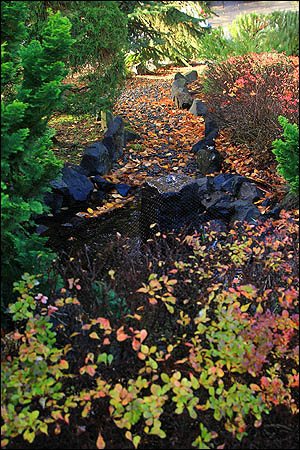
This drainage stuff can take a lot of experience to decipher. I do not represent myself as an interior water problem expert or a foundation expert.
My emphasis deals with potential solutions for exterior landscape drainage for water or rain. My 35 years (+) with trees, landscape and soil tends to set me apart from apparent "drainage masters" who may shine in the structural category.
Not to say that someone else may not be good. But from the walls outward to the fence, its fair to say that few people decipher the situation and solutions the way I do. And a lot of the problems I help to remedy like the root situation shown below stemmed from services offering "free estimates".
With every 10' x 10' piece of ground getting up to 2000 gallons of rain each year, drainage and rain is important to all of us. From Ashland and Medford, all the way up to Portland. But in autumn and winter, the Rogue Valley's rainfall is very similar to northern Oregon.
Images & Thumbnails - Click to Enlarge
Dry Creekbed Options
The right image presents a landscaping drainage and design project from August 2003, done from scratch. The smaller thumbnail following shows the same, but 9 years later, November 2012.
The dry creekbed behind the water feature is actually a horizontal cistern to catch runoff from the big driveway. A flat variation of the drywell with about 200 ft. of perforated pipe arranged in two layers.
You may have seen photos of round generic drywells set in a hole. Those are one option, but drainage drywells can take countless forms and shapes. Generic styles may concentrate collection and release in one spot. Modified or custom designs can disperse the moisture more broadly.
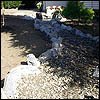
The small photo (enlarge) is from 2012, and opens to show the same 2003 project above the week of installation prior to planting.
The water feature in the background had nothing to do with the drainage. The water feature was only decorative. The problem was specifically rain water runoff from the driveway. In this case, it was possible to catch the water, redirect and release it elsewhere in the ground conveniently.
There's 100's of ways to design a dry creekbed with different shapes, layouts and plants. Those can be integrated with landscape drainage, French drains or water gardens. If the solution fits. That's just one of many drainage choices available.
About 1 out of 3 people who call me about drain lines do not need French drains as they expected. For many the real solution involves soil, lawn or other landscape drainage related changes.
Drainage work tends to involve residual problems that have been ignored or undiscovered for years, or from changes at other homes. Drainage can range from simple French drains to dry creek beds or decorative rock areas that offer cosmetic and aesthetic appeal. Sometimes it is better to collect and remove the water, and other times it may be better to divert water and slowly release it on the property where soil can handle moisture.

Click this Rock image to view another project. From about 2008
A lot of water was flowing down the sloped back yard, puddling next to the back of the house, which already had the one deck. The homeowners said they planned to add a 2nd deck in the future. So I tried a drainage variation using pond liner to collect rain, along with a shallow French drain to relocated that rain water plus extra from the slope. Although it may look flat in the image, the design is gently convex. The small rock was cosmetic in the interim.
In 2015 I happened to be next door and noticed the 2nd deck completed, covering the drainage concept beneath according to plan.
DIY - a few thoughts
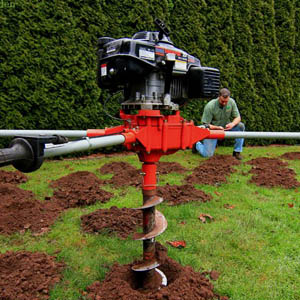
Various suggestions below may give a head start if you want to tackle it yourself if the matter is simple enough to keep your head above water.
Also, soil care and compaction are important to be aware of especially in rainy areas like Portland, were rain erodes or lubricates soil. Here are three related pages that may help:
Read: Soil Care
Read: Soil Compaction
Read: Auger and Drainage
The DIY drainage and French drain advice may help you avoid installing drainage that you don't need. Certainly you want to get rid of your problems, and sometimes a French drain is not the solution.
Basically, just like the illustration to the right below, a French Drain is more or less just a perforated pipe in a trench. Eventually covered with porous material like pea gravel or landscape / drainage rock. The simplicity vanishes when it comes to customizing the design for your site.
How can the soil affect the drain line life span? Where are the trees and shrubs and will the roots be a problem now or 10 years later? Will the rock become a projectile from lawn mower at windows? Can a pathway with flagstone become a French drainage design?
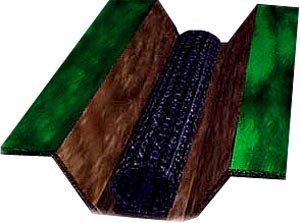
Typically, French drains include pipe near the bottom of a trench, with gravel or sand on top. If sand is used, a fabric cover or sleeve for the pipe will be essential. Small round rock is often most practical, but sand may have a reason.
The pipe is normally perforated to collect water eventually transition to solid to move water. If its a matter of spreading water away from a puddle, the pipe may all be perforated.
Drain lines can be built with a combination of perforated and solid drain pipe. Use perforated drainage pipe to gather water and solid pipe to move it from point A to point B. Perforated also functions to release water on the property if that's the intended design.
Digging drainage trench walls at an angle can be more stable, potentially reducing collapse of the edge. But the slanted sides are not essential for French drains. Straight walls can work too. Angled walls mean a wider top, and that can be impractical because more rock is needed and more soil must be relocated. Plus its more obvious.
Solid pipe is preferred near tree roots. If perforated pipe is located near trees or big shrubs, roots can grow into the gravel and drain line through perforations. There is little reason to use perforated pipe across areas where water will not be flowing into it.
Success depends on a variety of solutions and materials.
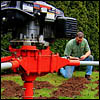
Image right: Using an auger (select image) to penetrate a hardpan compaction layer that was a residual artifact from farmland. A new neighborhood was built over farmland. At some homes, old barn and tractor driveways were not disturbed or decompacted, but just buried under a layer of extra soil during grading. Areas where livestock congregated can also cause hidden zones of compaction. Like where they fed or rested, or along where fencelines used to be. These are historical factors where visual evidence can be completely erased. Every decade as homes like this get older, the hidden historical cause may vaporize with time. Although, the problem remains, and sometimes it can be found.
Sometimes boring with an auger may help providing holes which are basically tiny circular drywells. The same basic concept can be done by digging a big submerged cavity to be filled with gravel called a drywell. This option depends on whether or not the soil beneath the surface will allow water to naturally drain-away or seep out in the days following.
Knowledge of soil & compaction may save installing a needless drain line.
Here is a story:
Years ago, a friend asked about installing drainage at his home in Oregon. Two "professional" area drain installers said he should install drainage for what they claimed was a "high water table".
They did not identify the real problem. They were looking at one symptom of a mushy lawn and guessing at both problem and solution.
The symptom was tiny standing puddles and mushy lawn after rain. It was actually from compaction and not from a high water table. Later, I pointed-out the old Oregon oak trees and Ponderosa Pines on his lot. Those would not flourish for 50 to 150 yrs. in a to-the-surface high water table. My friend was was convinced and we corrected soil conditions in the top few inches instead of wasting money on a French drain line.
Just one day for a new lawn, no trenches and no pipe. He saved a ton of money. Because if he did it the other way first proposed to him, it would have become two projects. To fix the problem, we removed the old sod, ammended the soil and rototilled it. Then planted grass seed. Problem solved: no mushy lawn, no standing water.
A bit of thanks to the trees in this case. They red-flagged the fake high water table even before I arrived. The trees were in sight after turning the corner, and the what-not-to-do was evident the length of a football field away. I would have figured it out anyway, but the trees made faster work of the matter.
Back to Functional dry creekbeds
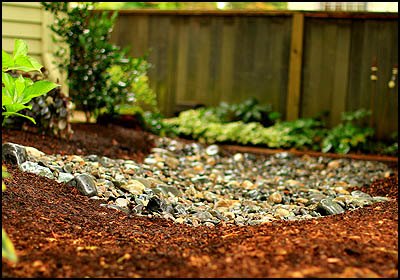
Again, the technique for drainage putting a drain line or drain lines underneath a dry creekbed. You can put several sections of perforated pipe next to each other parallel and layered one row of pipe on top of one another. This turns a dry creekbed into a holding cistern to control runoff or allow rain to seep into the property. This may not be a great idea in a back yard near a home at the bottom of a slope. Especially if there is not discharg pipe to release overflow elsewhere.
Image right: Concave collection. This is not a rock area to store, but to collect and release.
It may not be evident from the 50mm photo shallow depth of field but the rock shown covers almost 6 ft. x 20 ft. or 120 square feet.
Portland gets 3 feet of rain per year, so this recontoured part of the yard with pond liner beneath stone has potential to capture 360 cubic feet of water, 3 x 120. Each cubic foot has almost 7.5 gallons of water. So 360 x 7.5 = 2700 gallons.
That's how much water can be collected and released from part of a property and look decorative like a dry creek bed. Plants were added later.

advertisement
Drainage solutions are not limited to French drains but they sure have their place. A French drain trench is typically best with the rock exposed, enabling surface water to run into the trench.
Some French drains fail due to clogging. Some of this information is to prevent clogging. Like consider lining the wall of the trench with a fabric to prevent soil from migrating into the drainage rock fill and clogging the upper trench. There are countless French drains around homes that have closed over the top. The lower half may still be porous, but when the top encases the opening, most of the line is rendered useless.
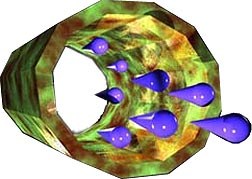
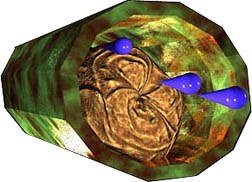
1. A way to avoid that is to slope sides of the trench so that the top is wider than the bottom. Basically this provides a “V” shape trench opening. When this is done, pressure on the top of the trench pushes energy down and outward on the sidewalls of the trench. If it's not feasible, don't worry about it.
2. Consider laying a landscape fabric in the trench before installing the French drain line pipe and gravel. This landscape fabric layer can hinders trench wall soil from pressing into the gravel. For those who cook, its similar to the idea of how cheesecloth separates and lets liquid pass through and retains solids. Be sure the fabric is porous. This is not an essential technique, but often helps.
3. Dig the trench a little deeper and lay one, two or a few inches of gravel on the bottom underneath the drain pipe. No matter how well a French drain line is built it probably will get clogged in the future whether 10 years down the road or 50 years from now. Every rain storm will move some silt into the drain line.
If the drain pipe is laid on the bottom of the trench, it will start to get plugged with sediment from the first time it functions. But if a few inches of gravel are laid under the drain tile, this gravel base will be what starts to accumulate the initial sediments. This can extend the life of the French drain. One redeeming factor is that sometimes even if the pipe clogs, the gravel can still move water above the pipe.
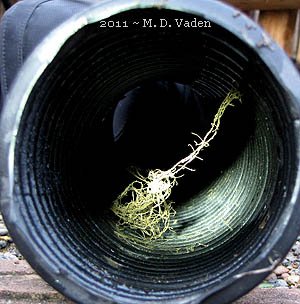
4. The finer the gravel used to fill the trench, the better for preventing collapse of the trench walls. If large rock is used to fill a French drain – like 2” to 3” diameter river rock – it’s easier for soil to move inward into the cavities between the rocks from the side walls of the French drain trench. Consider using pea gravel or fine gravel like ¼ - 10 crushed gravel. Fabric makes either stone about equal in this regard.
Image at right: Roots!
In northern Oregon, we replaced a so-called French Drain that another landscape contractor installed about 1 year earlier, where they also installed new sod lawn that covered some trenches in the middle. When we removed the perforated French drain pipe they installed toward the edges, fine roots had already grown through trench wall fabric and other fabric encasing the pipe. That was merely a year after their install. The image shows a view inside. The roots entered skinny and branched-out. Given time roots can engulf the inside.
5. Use washed gravel. Don’t get crushed gravel like ¼ minus that has a lot of dirt. Get gravel or rock like pea gravel or ¼ - 10 crushed rock that has been washed. You don’t need a bunch of dirt from gravel and filling your drain with sediment. The "minus" in a rock's name usually means it has soil in it. When the name has two particle sizes, it means it was screened, with very little soil and a lot more porous air space.
6. Gypsum has a tendency to chemically aggregate soil ... that’s good. It can help open up the soil structure and make it more permeable. Gypsum is inexpensive. It can be sprinkled on top of the finished trench and gravel and allowed to wash down.
7. If the trench will go by tree and shrub roots, consider inserting segments of solid drain line in those areas. If perforated drain tile is near roots, they can penetrate small openings and grow inside the drain line. The root mass will block water and render the drainage system ineffective.
8. Root barriers are available.
If you need a French drain to collect water near trees, consider placing a layer of root barrier against the trench wall between the tree roots and the drain line. The Portland area and suburbs have a lot of trees and big shrubs, and this is often encountered.
Root barriers can be available from bamboo supply businesses, some nurseries and garden centers.
Another source is tree or arborist supply. Some may be found online who ship. And I find pond liner to function reasonably well for this too, plus its locally available around Portland, Medford, Salem and Eugene. And elsewhere.
Wishing you the best on your project,
Mario Vaden